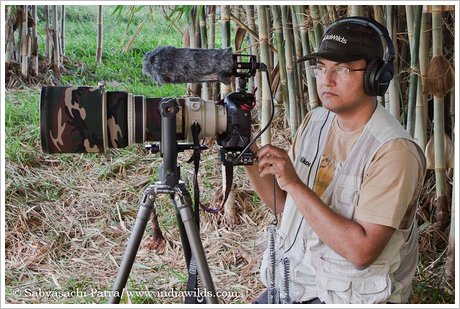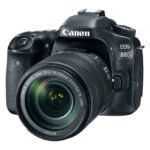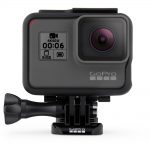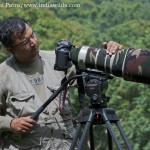Sennheiser MKH 416 P48 Microphone
Why I chose Sennheiser:
Sennheiser is one of the most reputed names in the microphones and audio electronics arena. Its microphones have got a reputation of tolerating humidity much better than other microphones. Most of the Sennheiser microphones are RF Condenser based so they tolerate humidity much better. On the other hand most of the other microphones are AF capacitor based and in high humidity conditions like sea side or in tropical rainforests etc there is a tendency for the charge to escape giving rise to the noise. The output is also reduced. The AF capacitor microphones also attract more dust. And in outdoors in India with all the dust and moisture, the situation is really tough. So as a Wildlife filmmaker, it is quiet natural to trust is Sennheiser’s RF condenser based microphones and put it in use in all weather conditions.
Sennheiser MKH 416:
The MKH 416 is a solid, versatile and no nonsense microphone. It has been launched some 40 yrs back, but due to its high popularity it is still being produced and marketed. It is used in major TV channels as well as in films, so it has attained a cult status. You can find many people using this microphone for the last thirty odd years and it is still going strong. So this microphone is likely to last for 20-30 yrs without any problem. In the second hand market it retains its value well. So buying a MKH 416 is a safe investment if you are likely to sell it off in near future.
This microphone requires phantom power which can be provided from a mixer or any decent recorder. It is 19mm in dia and 250mm long. The all black finish lends some elegance as well as doesn’t attract attention like some other flashy coloured microphones. In the wilderness areas, I am too scared about flashy colours. Of course, I never use this microphone without a softie or zeppelin.
When this microphone was first launched it was lapped up by people due to its directional characteristics. Its increased directivity is due to its interference tube principle. It has good off-axis sound rejection ie. the Sennheiser MKH 416 microphone isolates sound from the sides well. So during interviews and recording other sounds one needs to point this carefully at the source. Of course, now there are more modern designs available with better off axis sound isolation.
This MKH 416 microphone works well when handled by a boom operator in an interview, as well as handheld or on top of a camera. Ofcourse, any sound recordist worth his salt will tell you that the microphone should be as close to the source of sound and not on top of the camera, however, at times if you are a lone operator then you may make that compromise, as seen in this image taken a couple of years back.

If you are recording indoors, then one needs to look at the room size, presence or absence of sound damping surfaces like curtains, blinds etc and need to take into account the echoes before deciding the microphone to be used. Else, if you are using the MKH 416 in a smaller room, then you may not like the sound. The reason is simple laws of physics.
The direct sound from the source/interviewee passes through the front of the microphone. However, in the small rooms one needs to take into account the reflections from the walls as well. These reflections pass through the side walls as well as through the front of the microphone. When it enters through the front side of the microphone, it changes its phase and this sound mixes with the sound directly coming from the interviewee through the front of the microphone. The result is some frequencies gets cancelled or modified due to the difference in phase. The result is sometimes metallic or booming sound (depending upon the terminology you use to describe it). I was once forced to do an interview and despite the curtains and the longer room, one side was closer and led to slight metallic ring to the sound. For this purpose, I carry large green coloured beach towels which can be used in the forest as well as draped on the walls to make a difference. People often use blankets to dampen the sound from the walls or hard surfaces.
Characteristics of MKH 416:
Transformerless balanced output with an interference tube design.
RF Condenser Microphone
Polar Pattern: Supercardiod/Lobar
Frequency response: 40Hz – 20 KHz
Dynamic range – 117 dB
Maximum Input Sound Level (Passive) – 130 dB,
Sensitivuty 25 mV/Pa 1dB
Current consumption: 2 mA
Output Connectors – XLR-3M Type
Dimensions: 9.84 x 0.74 inch (250mm length x 19mm diameter)
Weight: 175 g
The Sennheiser MKH 416 comes in a case with a MZW 415 windshield and MZQ clamp.
One can place the MZW 415 windshield on the microphone for wind protection. However, if you need higher degree of wind protection, then you need to go for the wind muff or for severe winds a full-fledged zeppelin. In the image, you can see the rycote softie being used over the MKH 416. And if you observe carefully, you can see the rycote tag as well.
Consider buying a good recorder like the Sound Devices if you want professional quality, else you can go for the other recorders providing phantom power.
I have been using this microphone in the heat and dusty National parks chasing tigers as well as in the moist rainforests and other places without any problems. The 1200 USD spent in buying this microphone is well worth.
A Word of Caution:
Beginners may feel that they can record any sound from any distance. However, the fact is this MKH 416 microphone despite its increased off-axis rejection, doesn’t work like a telephoto lens. To get good sound, you have to be closer to the source of sound.
This is a versatile microphone and can be used in various situations, however, as photographers choose different lenses for different situations, similarly your sound recording requirements will dictate the use of other microphones as well.
While travelling in flight, keep some time in your hands as the security invariably checks my sound equipment especially the microphone as it appears like a rod.
If you have any queries regarding the Sennheiser MKH 416 Microphone Review you can ask in the comments section below.
You can buy the Sennheiser MKH 416 microphone by following this link from B&H, avail the prevailing discounts and help sustain our site: http://www.bhphotovideo.com/c/buy/Sennheiser_MKH_416/Ntt/Sennheiser%2BMKH%2B416/N/0/kw/search/BI/19990/KBID/13252/DFF/d10-v1-t12
Sennheiser MKH 416 microphone can be bought from the Amazon India link below:
- GoPro Hero 12 Black - 6 September,2023
- Leopards: The Last Stand - 2 July,2023
- Drifting in the Waters of Sundarbans - 26 March,2023










good read!! very thorough.
Hi, thanks for sharing your insights!
Hello,
Your article is very interesting.
Which shock mount did you use?
Is it a hot shoe mount?
Thanks a lot!